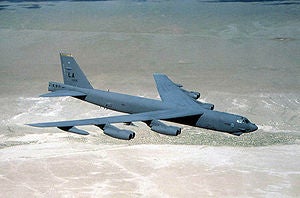Yesterday marked the 60th anniversary of the B-52 Stratofortress strategic bomber’s first flight. The last B-52 came off the production line 10 years later. Such milestones are often celebrated nostalgically for their achievements in times past. However, we can’t call them the “good old days” quite yet for the B-52, since many are still flying today.
This fact is a testament to the Air Force and industry’s ability to keep B-52s not only flying but relevant for more than half a century. However, it also underscores a rapidly spreading concern throughout the Department of Defense: The U.S. is increasingly relying on old equipment for national security.
The B-52 is just one of a surprising number of geriatric planes, ships, and other military assets still in use by the U.S. Armed Forces today. In spite of this unsettling trend, the Obama Administration has made recapitalizing national security its lowest priority by cutting the defense budget and pushing new platforms such as the F-35 Joint Strike Fighter and Ohio-class nuclear ballistic missile submarine replacement farther into the future.
Failing to replace old equipment like the B-52 is a double-edged sword. While this particular program has performed admirably, it still suffers the wear and tear of a long service life and high mileage. Maintenance costs inherently rise with the age of equipment. Furthermore, Obama’s policy of pushing new programs further into the future risks cost increases to these programs. It also puts national security at risk if the U.S. enters an unforeseen conflict ill-equipped.
The Stratofortress has admirably protected America through strategic nuclear deterrence and conventional missions in myriad conflicts for more than half a century. However, the U.S. cannot rely on this platform forever. It has become vulnerable to new enemy air defenses, for example. The Air Force also conceded that the next-generation bomber will not be certified to perform nuclear missions until the same timeframe that B-52s are scheduled to retire. This schedule assumes that B-52s will not see an increase in use due to an unforeseen conventional or non-conventional conflict. Any additional stress could shorten the fleet’s lifespan, leaving a gap in strategic nuclear deterrence capability. Delaying nuclear certifications for the new bomber puts national security at risk.
President Obama has already made it clear that he wants to reduce America’s nuclear arsenal. Doing so while weakening U.S. strategic deterrence puts national security at risk and erodes America’s leadership position in the world. With the submarine leg of the triad already scheduled to fall below its required level of capability, reliance on bombers will not be declining any time soon. Obama and Congress should recognize this by fully funding a next-generation strategic bomber program and a robust defense budget.





























